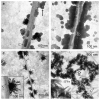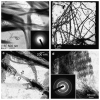Hierarchical and non-hierarchical mineralisation of collagen
- PMID: 21040969
- PMCID: PMC3003335
- DOI: 10.1016/j.biomaterials.2010.10.018
Hierarchical and non-hierarchical mineralisation of collagen
Abstract
Biomineralisation of collagen involves functional motifs incorporated in extracellular matrix protein molecules to accomplish the objectives of stabilising amorphous calcium phosphate into nanoprecursors and directing the nucleation and growth of apatite within collagen fibrils. Here we report the use of small inorganic polyphosphate molecules to template hierarchical intrafibrillar apatite assembly in reconstituted collagen in the presence of polyacrylic acid to sequester calcium and phosphate into transient amorphous nanophases. The use of polyphosphate without a sequestration analogue resulted only in randomly-oriented extrafibrillar precipitations along the fibrillar surface. Conversely, the use of polyacrylic acid without a templating analogue resulted only in non-hierarchical intrafibrillar mineralisation with continuous apatite strands instead of discrete crystallites. The ability of using simple non-protein molecules to recapitulate different levels of structural hierarchy in mineralised collagen signifies the ultimate simplicity in Nature's biomineralisation design principles and challenges the need for using more complex recombinant matrix proteins in bioengineering applications.
Copyright © 2010 Elsevier Ltd. All rights reserved.
Figures








References
-
- Wang L, Nancollas GH. Pathways to biomineralization and biodemineralization of calcium phosphates: the thermodynamic and kinetic controls. Dalton Trans. 2009;15:2665–2672. - PubMed
-
- Saito T, Arsenault AL, Yamauchi M, Kuboki Y, Crenshaw MA. Mineral induction by immobilized phosphoproteins. Bone. 1997;21:305–311. - PubMed
-
- Cölfen H. Bio-inspired mineralization using hydrophilic polymers. Top Curr Chem (Springer-Verlag, Berlin: Heidelberg) 2007;271:1–77.
Publication types
MeSH terms
Substances
Grants and funding
LinkOut - more resources
Full Text Sources
Other Literature Sources

